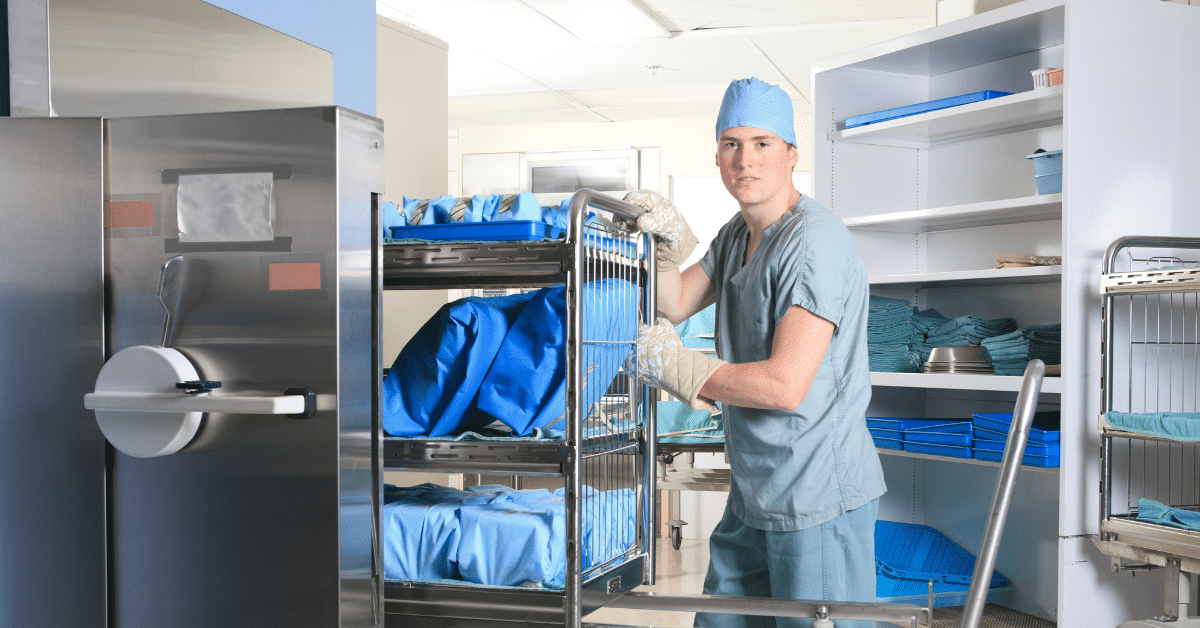
A Day in the Life of a Sterile Processing Technician
A Sterile Processing Technician plays an integral role in healthcare, ensuring that all medical instruments and equipment are properly sterilized and ready for use in various medical procedures. This position is critical for maintaining the highest standards of cleanliness and infection control in healthcare settings. From the meticulous cleaning of surgical instruments to their sterilization and preparation for reuse, these technicians ensure that healthcare providers have the tools they need to safely treat patients. A day in the life of a Sterile Processing Technician is a blend of rigorous attention to detail, adherence to strict sterilization protocols, and a continuous commitment to patient safety. Here’s a typical day:
Start of the Shift
At the beginning of their shift, a Sterile Processing Technician gears up in the appropriate attire, which is crucial for maintaining a sterile environment. This typically includes wearing scrubs, gloves, masks, and sometimes protective gowns. Once appropriately dressed, the technician reviews the day’s schedule and familiarizes themselves with the equipment and instrument needs. Understanding the urgency and priority of tasks is essential, as some procedures may require instruments more urgently than others. This initial phase sets the tone for the day and ensures that the technician is prepared for the tasks ahead.
Decontamination
Decontamination is a vital part of the technician’s day. They collect used and contaminated instruments from various departments, such as surgery, and transport them to the decontamination area. Here, using specialized equipment and chemicals, the technician meticulously cleans these instruments. This process is critical for preventing the spread of infections and ensuring that the instruments are safe for reuse. The technician must adhere to strict protocols during this phase to effectively remove biological debris and other contaminants.
Inspection and Preparation
After decontamination, each instrument undergoes a thorough inspection for cleanliness and functionality. The technician checks for any damage or malfunction, setting aside any items that need repair or replacement. They then assemble the cleaned instruments into sets or trays according to the specific requirements of various medical procedures. This task requires a keen eye for detail and an extensive knowledge of medical instruments and their uses.
Sterilization
Sterilization is a critical step in the process. The technician loads the prepared instrument sets into sterilizers, choosing the appropriate method of sterilization such as steam, dry heat, or chemical vapor. They closely monitor the sterilization process, ensuring that all parameters, such as temperature and duration, are correctly met. This step is crucial for eliminating all microbial life from the instruments, ensuring they are safe for patient use.
Storage and Distribution
Post-sterilization, the items are stored in a sterile environment until they are needed. The technician ensures that they are stored correctly to maintain their sterility. In addition to storage, the technician manages the inventory, keeping track of which items are in use, what needs to be reordered, and what is readily available. This role is essential for ensuring that the healthcare facility never runs short of necessary instruments.
Documentation and Compliance
Throughout their day, the technician maintains detailed records of sterilization cycles, equipment maintenance, and inventory levels. These records are crucial for compliance with health and safety regulations. The technician must ensure that all processes are documented accurately and that the facility adheres to the latest standards and protocols in sterilization and infection control.
Continuous Learning
Sterile Processing Technicians often engage in ongoing education and training. This continuous learning is vital for staying up-to-date with the latest sterilization techniques, understanding new types of medical instruments, and complying with evolving health and safety standards. This aspect of the job requires a commitment to professional development and a willingness to constantly improve and adapt.
End of the Shift
At the end of their shift, the technician prepares the workspace for the following day or the next shift. This might include cleaning the work area, setting up sterilization equipment, and restocking supplies. Ensuring that the department is ready for the next team is a crucial part of the role, as it facilitates a seamless transition and maintains the efficiency of the sterilization process.
This role is critical in any healthcare setting as it directly impacts patient safety and the success of medical procedures. The meticulous work of a Sterile Processing Technician ensures that medical teams can trust the sterility and functionality of their instruments, thereby contributing significantly to patient care. Every instrument that passes through their hands plays a vital role in surgeries, diagnostics, and other medical procedures. The responsibility carried by Sterile Processing Technicians goes beyond just cleaning and sterilizing; they are guardians of patient health, working behind the scenes to prevent infection and ensure successful outcomes in medical treatments. Their attention to detail, knowledge of sterilization techniques, and commitment to rigorous protocols are essential for maintaining the high standards of healthcare. In essence, a day in the life of a Sterile Processing Technician is about ensuring the safest and most effective environment for patient care, making them unsung heroes in the healthcare industry.
Share This Article
Similar Blogs
What is a Pediatric Occupational Therapy Assistant?
When children face challenges that impede their ability to participate in daily activities, the role of pediatric occupational therapy becomes essential in supporting their growth and development. Within…
Posted: 2 Days Ago
Benefits of Working in a Long-Term Care Facility
Working in a long-term care facility presents unique opportunities and rewards that can be fulfilling both personally and professionally. For many healthcare professionals, the decision to work in…
Posted: 2 Days Ago
Working as a Speech-Language Pathologist (SLP) in School Settings: What to Expect, Pros and Cons
When considering a career in speech-language pathology (SLP), the school setting is one of the most popular avenues for professional practice. Schools across the country rely on SLPs…
Posted: 2 Days Ago


